Giorgio Napolitano facts for kids
Quick facts for kids
Giorgio Napolitano
|
|||||||||||||||||||||||||||||||||||
|---|---|---|---|---|---|---|---|---|---|---|---|---|---|---|---|---|---|---|---|---|---|---|---|---|---|---|---|---|---|---|---|---|---|---|---|
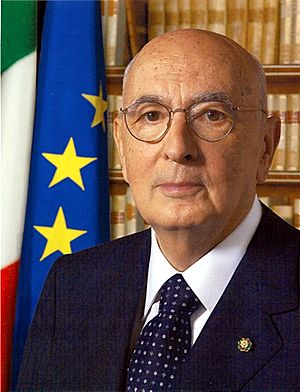
Official portrait, 2006
|
|||||||||||||||||||||||||||||||||||
| President of Italy | |||||||||||||||||||||||||||||||||||
| In office 15 May 2006 – 14 January 2015 |
|||||||||||||||||||||||||||||||||||
| Prime Minister | |||||||||||||||||||||||||||||||||||
| Preceded by | Carlo Azeglio Ciampi | ||||||||||||||||||||||||||||||||||
| Succeeded by | Sergio Mattarella | ||||||||||||||||||||||||||||||||||
| President of the Chamber of Deputies | |||||||||||||||||||||||||||||||||||
| In office 3 June 1992 – 14 April 1994 |
|||||||||||||||||||||||||||||||||||
| Preceded by | Oscar Luigi Scalfaro | ||||||||||||||||||||||||||||||||||
| Succeeded by | Irene Pivetti | ||||||||||||||||||||||||||||||||||
| Minister of the Interior | |||||||||||||||||||||||||||||||||||
| In office 18 May 1996 – 21 October 1998 |
|||||||||||||||||||||||||||||||||||
| Prime Minister | Romano Prodi | ||||||||||||||||||||||||||||||||||
| Preceded by | Giovanni Rinaldo Coronas | ||||||||||||||||||||||||||||||||||
| Succeeded by | Rosa Russo Iervolino | ||||||||||||||||||||||||||||||||||
|
|||||||||||||||||||||||||||||||||||
| Personal details | |||||||||||||||||||||||||||||||||||
| Born | 29 June 1925 Naples, Kingdom of Italy |
||||||||||||||||||||||||||||||||||
| Died | 22 September 2023 (aged 98) Rome, Italy |
||||||||||||||||||||||||||||||||||
| Political party | Independent (2006-2023) | ||||||||||||||||||||||||||||||||||
| Other political affiliations |
|
||||||||||||||||||||||||||||||||||
| Spouse |
Clio Maria Bittoni
(m. 1959) |
||||||||||||||||||||||||||||||||||
| Children | 2 | ||||||||||||||||||||||||||||||||||
| Alma mater | University of Naples Federico II | ||||||||||||||||||||||||||||||||||
| Signature | |||||||||||||||||||||||||||||||||||
Giorgio Napolitano (born 29 June 1925 – died 22 September 2023) was an important Italian politician. He served as the President of Italy from 2006 to 2015. He was the first president to be chosen for a second term. People sometimes called him "King Giorgio" because he was so influential in Italian politics. He was the oldest and longest-serving president in the history of the Italian Republic, which started in 1946.
Napolitano was a member of the Italian Communist Party from 1945. He joined after being part of the Italian resistance movement during World War II. Later, he was part of other parties that grew from the Communist Party. He was known for being a moderate and reform-minded leader within his party. He was first elected to the Chamber of Deputies (one of Italy's parliament houses) in 1953. He later became the President of the Chamber of Deputies from 1992 to 1994. From 1996 to 1998, he was the Minister of the Interior. He was also the first high-ranking leader from a Communist party to visit the United States in 1978.
In 2005, President Carlo Azeglio Ciampi made Napolitano a senator for life. In 2006, the Italian Parliament elected him President of Italy. He was the first former Communist to become Italy's president. During his time as president, he worked with both centre-left and centre-right governments. When Silvio Berlusconi resigned as prime minister in 2011 due to economic problems, Napolitano asked Mario Monti to form a new government.
When his first seven-year term ended, Napolitano, who was 87, agreed to serve a second term. This was to help Italy during a difficult time when Parliament couldn't agree on a new government. He invited Enrico Letta to form a government. Later, when Letta resigned, Napolitano asked Matteo Renzi to form a new government. After serving for eight and a half years, Napolitano resigned in January 2015 because of his age. He was 89 years old. He then returned to his seat in the Italian Senate and stayed there until he passed away in 2023.
Many people praised Napolitano for helping Italy through tough times, especially during the European debt crisis. They said he helped stabilize the country.
Contents
Early Life and Education
Napolitano was born in Naples, Campania, in 1925. His father, Giovanni, was a lawyer and poet. His mother, Carolina Bobbio, came from a noble family. He studied at a high school in Naples and later in Padua. In 1942, he started studying law at the University of Naples Federico II.
During his university years, he joined a youth group called Gioventù Universitaria Fascista. However, he and his friends secretly opposed Italian fascism. He later said this group was a place where anti-fascist ideas grew, even though it was disguised. Napolitano loved theatre and even acted in some plays. He also wrote a book called Movimento Operaio e Industria di Stato (Workers' Movement and State Industry) in 1962.
World War II and Resistance
During World War II, from 1943 to 1945, Italy had a puppet state called the Italian Social Republic, controlled by Nazi Germany. Napolitano and his friends joined the Italian resistance movement. They fought against the German and Italian fascist forces.
Start of Political Career
Post-War Years and the Communist Party
After the war ended in 1945, Napolitano joined the Italian Communist Party (PCI). He became a leader for the party in Naples and Caserta. In 1947, he finished his law degree. His final paper was about why southern Italy didn't develop industrially after the Unification of Italy. He worked to help southern Italy for over ten years.
In 1953, Napolitano was first elected to the Chamber of Deputies for Naples. He was re-elected many times until 1996. In 1956, he joined the party's National Committee. He became responsible for issues related to Southern Italy.
In 1956, the Hungarian Revolution of 1956 happened, and the Soviet Union (USSR) stopped it with military force. The Communist Party in Italy supported the Soviet Union's actions. Napolitano later said he felt uncomfortable with this decision. He believed his support was because the Italian Communist Party felt connected to the Soviet Union's socialist goals.
Leading the Italian Communist Party
From the 1960s to the 1980s
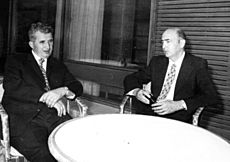
From 1963 to 1966, Napolitano was the party chairman in Naples. From 1966 to 1969, he led the party's political office. After the death of party leader Togliatti in 1964, Napolitano supported an alliance with the Italian Socialist Party. During the 1970s and 1980s, he handled the party's cultural activities, economic policy, and international relations.
Napolitano was a moderate voice within the Communist Party. He led a group called migliorismo, which meant "betterment". This group wanted to reform the party and make it more like other democratic socialist parties in Western Europe.
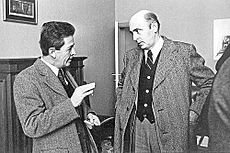
In the mid-1970s, Napolitano was invited to speak in the United States. However, the US ambassador to Italy refused him a visa because he was a Communist. Between 1977 and 1981, Napolitano had secret meetings with the US ambassador. This was when the Italian Communist Party was trying to improve its relationship with the US. They were also moving away from the Communist Party of the Soviet Union.
Thanks to these efforts, Napolitano was able to travel to the United States in the 1980s. He gave lectures at places like Harvard University. He visited the US many times after that. In 1989, Napolitano became the Foreign Minister in the Communist Party's shadow government. He supported the changes that led to the party changing its name and direction.
After the Italian Communist Party
In 1991, the Italian Communist Party was dissolved. Napolitano joined most of its members in forming the Democratic Party of the Left. This new party was a democratic socialist and social democratic party. It was seen as the next step for the former Communist Party.
President of the Chamber of Deputies
In 1992, Napolitano was elected President of the Chamber of Deputies. He took over from Oscar Luigi Scalfaro, who became President of Italy. During his time as president of the Chamber, Italy faced a big corruption scandal called Tangentopoli.
Later Political Roles
After the 1996 election, Romano Prodi, the centre-left Prime Minister, chose Napolitano as Minister of the Interior. He was the first former Communist to hold this important position. He helped create a law about immigration control. Napolitano stayed in this role until 1998.
Napolitano also served a second term as a member of the European Parliament from 1999 to 2004. In 2005, President Carlo Azeglio Ciampi appointed him as a senator for life.
President of Italy
First Term (2006–2013)
Election to President
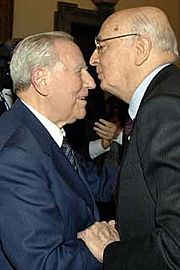
In 2006, Italy held a general election. The centre-left coalition, led by Romano Prodi, won. After the election, the winning coalition chose Napolitano as their candidate for President of Italy. The centre-right opposition wanted a neutral candidate.
On 7 May, the centre-left officially supported Napolitano for the 2006 Italian presidential election. Even the Holy See (the Vatican) supported him. Napolitano was elected on 10 May. He received 543 votes out of 1,009. At 80 years old, he became the first former Communist to become President of Italy. He came out of retirement to take on this important role. He started his term on 15 May.
Working with Governments
On 9 July 2006, Napolitano was at the FIFA World Cup final. The Italian team won, and he joined their celebrations. He was the second Italian president to see Italy win the World Cup. In September 2006, he visited Budapest, Hungary. He paid tribute to those who died in the 1956 revolution, which he had initially opposed.
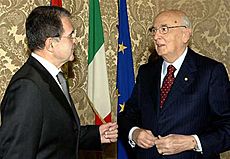
In February 2007, Prime Minister Prodi resigned after losing a vote in Parliament. Napolitano refused his resignation. He asked Prodi to seek a new vote of confidence, which Prodi won. This allowed his government to stay in office.
2008 Political Challenges
In January 2008, Prodi's government lost a vote of confidence in the Senate. Napolitano then asked the Senate president, Franco Marini, to try and form a temporary government. The goal was to change the election system. However, Marini failed to find enough support.
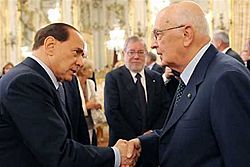
On 6 February, Napolitano dissolved the Italian Parliament. This led to a new election in April 2008. Silvio Berlusconi's centre-right coalition won this election. On 7 May, Napolitano appointed Berlusconi as Prime Minister of Italy. Berlusconi became the second Prime Minister under Napolitano's presidency.
2011 Economic Crisis
In October 2011, the Chamber of Deputies rejected the government's budget law. Berlusconi won a confidence vote, but his support was very weak. On 8 November, the budget law was approved, but with even fewer votes. This showed Berlusconi had lost his majority.
After this, Berlusconi announced he would resign once economic reforms were passed. On 12 November, Berlusconi officially resigned. Napolitano then appointed former European Commissioner Mario Monti as a senator for life. He then asked Monti to become the new Prime Minister. Monti's government was strongly supported by both houses of Parliament. Napolitano's actions during this crisis were praised by many world leaders.
Second Term (2013–2015)
Re-election as President

After five failed attempts to elect a new president in 2013, Napolitano agreed to be re-elected. This was a very unusual step. He did this to help Italy's political system during a time of great uncertainty. Napolitano was easily re-elected on 20 April, getting 738 out of 1,007 votes. He was sworn in on 22 April and asked for important reforms.
Forming New Governments

After his re-election, Napolitano immediately started talks with political leaders. On 24 April, he asked Enrico Letta to form a government. Letta's government was a "grand coalition" with support from different parties. This was the first time in Italy's history that all major parties from the election joined the government. Letta became Prime Minister on 28 April.

In 2013, Matteo Renzi, the mayor of Florence, became the new leader of the Democratic Party. He called for a "new phase" and "radical program" for Italy. On 14 February 2014, Napolitano accepted Letta's resignation.
On 17 February, Napolitano asked Renzi to form the new Italian government. Renzi formed a cabinet with members from different parties. It was Italy's youngest government ever, with an average age of 47. It was also the first with an equal number of male and female ministers. Renzi was sworn in as Prime Minister on 22 February.
Resignation
On 9 November 2014, news reports said that Napolitano would step down. He officially resigned on 14 January 2015. This was after Italy's six-month presidency of the European Union ended.
Later Life and Passing
After his presidency, Napolitano became a senator for life again. He joined a political group in the Senate. In 2018, he had heart surgery. He also had abdominal surgery in 2022.
Death
In 2023, Napolitano was hospitalized in Rome. On 19 September, his health became critical. He passed away three days later, on 22 September, at the age of 98. At the time of his death, he was the only living former Italian president.
Honours and Awards
Napolitano received many awards from Italy and other countries for his service. These include:
- Head of the Order of Merit of the Italian Republic (Italy's highest honor)
- Grand Cross of the Order of Merit of the Italian Republic
- Grand Star of the Decoration of Honour for Services to the Republic of Austria
- Collar of the Order of the Southern Cross (Brazil)
- Grand Cross of the Grand Order of King Tomislav (Croatia)
- Grand Cross of the Order of the Legion of Honour (France)
- Grand Cross Special Class of the Order of Merit of the Federal Republic of Germany
- President's Medal (Israel)
- Collar of the Order of Mubarak the Great (Kuwait)
- Knight Grand Cross of the Order of the Gold Lion of the House of Nassau (Luxembourg)
- Honorary Companions of Honour with Collar of the National Order of Merit (Malta)
- Grand Cross of the Order of the Netherlands Lion
- Grand Cross of the Order of the White Eagle
- Collar of the Order of the Star of Romania
- Collar of the Order of San Marino
- Collar of the Order of King Abdulaziz (Saudi Arabia)
- Grand Cross of the Order of the White Double Cross (Slovakia)
- Member of the Order for Exceptional Merits (Slovenia)
- Recipient of the Grand Order of Mugunghwa (South Korea)
- Knight of the Royal Order of the Seraphim (Sweden)
- First Class of the Order of the State of Republic of Turkey
- Knight with the Collar Order of Pius IX (Vatican City)
He also received the Dan David Prize for his work in strengthening democracy in Italy and Europe.
Images for kids
See also
 In Spanish: Giorgio Napolitano para niños
In Spanish: Giorgio Napolitano para niños



